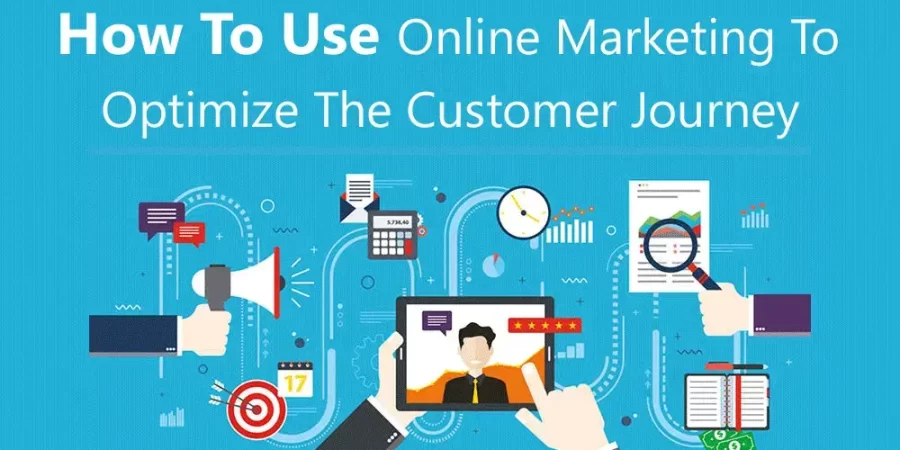Beginners Guide: How To Use Online Marketing To Optimize The Customer Journey?
Online marketing has become a crucial component in the success of businesses in today’s digital age. One important aspect of online marketing is optimizing the customer journey, which refers to the steps a customer takes from awareness of a product or service to post-purchase evaluation. In this article, we will discuss various strategies and techniques for using online marketing to optimize the customer journey.
Understanding the Customer Journey
The first step in optimizing the customer journey is understanding it. The customer journey typically includes the following stages:
- Awareness: This is the stage where the customer becomes aware of a product or service and begins to research it.
- Interest: During this stage, the customer becomes more interested in the product or service and begins to gather more information about it.
- Consideration: At this stage, the customer compares different products or services and decides which one to purchase.
- Purchase: The customer makes a purchase and becomes a customer.
- Post-purchase evaluation: The customer evaluates their experience with the product or service and decides whether to purchase again.
Optimizing the Awareness Stage
- Search Engine Optimization (SEO): SEO is the process of optimizing a website to rank higher in search engine results. This can be done by using keywords in the website’s content and meta tags, as well as by building high-quality backlinks to the website.
- Pay-Per-Click (PPC) Advertising: PPC advertising allows businesses to place ads on search engine results pages and only pay when someone clicks on the ad. This can be a highly effective way to increase visibility and drive traffic to a website.
- Content Marketing: Content marketing involves creating valuable, informative content that attracts and engages a target audience. This can include blog posts, videos, infographics, and more.
Optimizing the Interest Stage
- Email Marketing: Email marketing allows businesses to communicate directly with customers and keep them updated on new products, sales, and other promotions.
- Social Media Marketing: Social media platforms like Facebook, Instagram, and Twitter can be used to connect with customers and provide them with valuable information about products and services.
- Webinars and Live Events: Hosting webinars or live events can be an effective way to provide customers with valuable information and build trust with them.
Optimizing the Consideration and Purchase Stages
- Product Pages: A website’s product pages should be designed to be as informative and user-friendly as possible, including detailed product descriptions, high-quality images, and customer reviews.
- Shopping Cart Optimization: Shopping cart optimization involves making the checkout process as smooth and easy as possible. This can include things like offering multiple payment options, displaying the total cost upfront, and providing clear and concise instructions.
- Customer Service: Providing excellent customer service can help to build trust with customers and increase the likelihood of repeat business. This can include things like providing live chat support, responding quickly to customer inquiries, and offering a money-back guarantee.
Optimizing the Post-Purchase Evaluation Stage
- Follow-up Emails: Sending follow-up emails to customers can be an effective way to get feedback on their experience and encourage them to make another purchase.
- Surveys: Surveys can be used to gather valuable feedback from customers about their experience with a product or service.
- Retargeting: Retargeting is a form of online advertising that allows businesses to display ads to people who have previously visited their website. This can be an effective way to bring customers back to a website and encourage them to make another purchase.
Measuring and Analyzing the Customer Journey
- Analytics: Using analytics tools like Google Analytics can help businesses track and measure various aspects of the customer journey, such as website traffic, conversion rates, and customer behavior.
- A/B Testing: A/B testing is a method of comparing two different versions of a website or marketing campaign to see which one performs better. This can be used to optimize various aspects of the customer journey, such as the design of a product page or the copy in an email marketing campaign.
- Heat Mapping: Heat mapping is a visual representation of where visitors are clicking on a website. This can be used to identify areas of a website that are not performing well and make improvements.
Personalization
Personalization is another important aspect of optimizing the customer journey. By gathering data on customers and using it to tailor the customer experience, businesses can create a more personalized and engaging experience for each customer. Personalization can take many forms, such as personalized recommendations, targeted promotions, and customized content.
- Personalized Recommendations: By gathering data on customers’ browsing and purchase history, businesses can make personalized recommendations for products or services that may be of interest to them. This can be done on a website, in an email campaign, or through a personalized push notification.
- Targeted Promotions: By segmenting customers based on their characteristics and behavior, businesses can create targeted promotions that are more likely to be of interest to them. This can include targeted discounts, special offers, or exclusive promotions.
- Customized Content: By gathering data on customers’ preferences and interests, businesses can create customized content that is tailored to their specific needs. This can include customized email campaigns, personalized web pages, and more.
Mobile Optimization
With the increasing use of mobile devices to access the internet, mobile optimization has become a crucial aspect of online marketing. By optimizing a website and marketing campaigns for mobile devices, businesses can ensure that customers have a positive experience regardless of the device they are using.
- Mobile-Friendly Website: A mobile-friendly website is one that is optimized for smaller screens and touch-based navigation. This can include things like larger font sizes, larger buttons, and a simplified layout.
- Accelerated Mobile Pages (AMP): AMP is an open-source framework that allows businesses to create web pages that load quickly on mobile devices. This can help to improve the customer experience and increase the likelihood of conversions.
- Mobile App: A mobile app can be a powerful tool for engaging customers and providing them with a personalized experience. This can include things like push notifications, customized content, and personalized recommendations.
Here are some key takeaways from the article on “How to use online marketing to optimize the customer journey”:
- Understanding the Customer Journey: The first step in optimizing the customer journey is understanding it. The customer journey typically includes the following stages: Awareness, Interest, Consideration, Purchase, and Post-purchase evaluation.
- Optimizing the Awareness Stage: This stage involves increasing visibility of the product or service and driving traffic to the website. Strategies include Search Engine Optimization (SEO), Pay-Per-Click (PPC) Advertising, and Content Marketing.
- Optimizing the Interest Stage: This stage involves engaging with potential customers and providing them with valuable information. Strategies include Email Marketing, Social Media Marketing, and Webinars and Live Events.
- Optimizing the Consideration and Purchase Stages: This stage involves providing customers with the information they need to make a purchase and making the checkout process as easy as possible. Strategies include Product Pages, Shopping Cart Optimization, and Customer Service.
- Optimizing the Post-Purchase Evaluation Stage: This stage involves getting feedback from customers on their experience and encouraging repeat business. Strategies include Follow-up Emails, Surveys, and Retargeting.
- Measuring and Analyzing the Customer Journey: To understand what is working and what isn’t, it’s important to track and measure various aspects of the customer journey, such as website traffic, conversion rates, and customer behavior. Strategies include Analytics, A/B Testing, and Heat Mapping.
- Personalization: Personalization is another important aspect of optimizing the customer journey. By gathering data on customers and using it to tailor the customer experience, businesses can create a more personalized and engaging experience for each customer. Strategies include Personalized Recommendations, Targeted Promotions, and Customized Content.
- Mobile Optimization: With the increasing use of mobile devices to access the internet, mobile optimization has become a crucial aspect of online marketing. Strategies include creating a Mobile-Friendly Website, Accelerated Mobile Pages (AMP), and Mobile App.
In conclusion, optimizing the customer journey is a crucial aspect of online marketing. Through understanding the different stages of the customer journey and implementing strategies such as SEO, PPC advertising, email marketing, and social media marketing, businesses can increase conversions and improve customer satisfaction.
Furthermore, by personalizing the customer experience and making sure the website and marketing campaigns are mobile optimized, businesses can create a more engaging and personalized experience for each customer.
But, it’s important to measure and analyze the customer journey to understand what is working and what isn’t and make necessary improvements. With the right approach, online marketing can be a powerful tool for businesses looking to optimize the customer journey and drive success in today’s digital age.





Leave a Reply